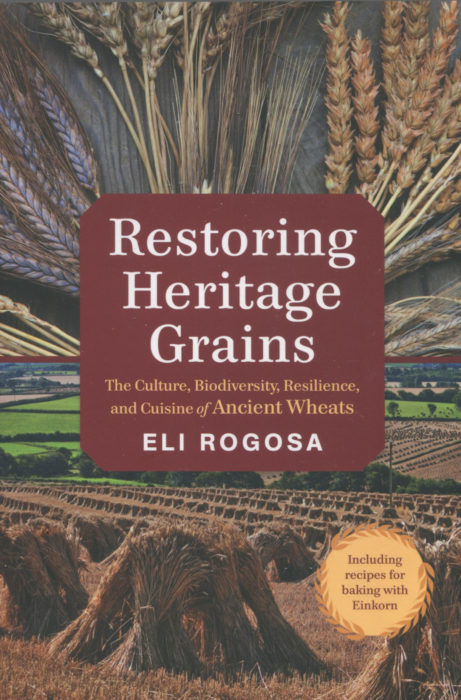
This book was featured at this year’s Kneading Conference in Skowhegan, Maine.
First, a plug for the conference. Suzi and I have gone every other year for decades for three days of classes and seminars by bakers and farmers devoted to the craft and the art of baking. Especially wood oven baking. This year, the conference significantly upgraded its venue, so we plan on going every year going forward. If you love bread, come. Folks are here from across the United States and Europe.
This important book was one of the gems featured at this year’s conference. Its subtitle tells you all: The Culture, Biodiversity, Resilience and Cuisine of Ancient Wheats. Author Eli Rogosa traveled to the Middle East to explore the origins of cultivated wheat and to discover, to his amazement, the very different way that seeds and grains are treated there.
In America, wheat is agribusiness and Monsanto is the elephant in the room. Diversity of wheat types has dwindled in this country: mass production is preferred over variety. And over flavor.
The lack of diversity means more than that lack of flavor. It increases our risk of some disaster if the Monsanto seed scientists find themselves surprised by a new disease. Or if more Americans develop wheat allergies. The rise in peanut allergies, for unknown reasons, is proof that serious new conditions can creep into our population. And create havoc.
Chapters here focus on the risks of extinction of current grain species, discovery landrace grans, and enjoying the flavors of this diversity. Landrace? You’ve heard of terroir for grapes and wine. Landrace is the same idea but for wheat. In other parts of the world, where farming not industrial, you can find farmers with grains that have been cultivated for centuries on the same smallish plots of land. The wheat species have evolved and represent very specific and definitive varietals.
Learning about these “new” old grains, and learning how we might propagate them, is Eli’s happy mission in this book.
In the final chapter, A Taste of History, different grains are presented along with matching and very ethnic recipes.
For example, einkorn is one of those recently “rediscovered” grains that is now increasingly popular. There are einkorn books and you can find the grain in many upscale markets. In this book, you’ll find the authentic way to use the grain. There is a Jewish recipe from Poland for Kreplach, dumplings filled with savory elements like meat or cheese. Similar to Italian tortellini or Chinese wontons, the recipe could not be simpler: 3 cups of einkorn flour, a teaspoon of salt, and 4 beaten eggs. The filling can be sauce or the meat of your choice or some cheese or, I suppose, you own concoction of all three.
There are many other einkorn recipes and detailed tips. Alert: it’s not the easiest grain to work with as Suzi and I have learned. This book offers a graceful path to success.
There is an intense recipe for Chocolate Babka with 20 ingredients employed in a ganache filling, the dough itself, and a streusel topping. It’s the perfect example of the detail and specificity that Eli displays in the book. If you are a baker, if you care about authenticity, if you are curious about the evolution of wheat, then Restoring Heritage Grains is an important book. And a delicious one too!
